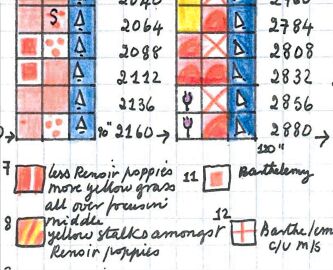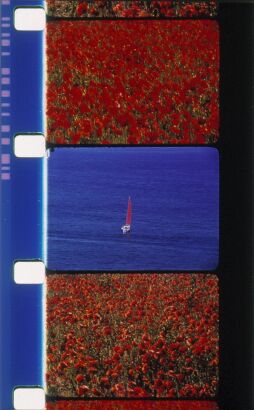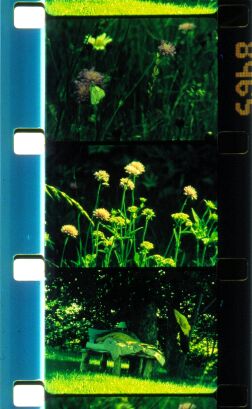
Numero 4 (Pip
Chodorov, 1989), super-8, color, sound, 3 minutes (screened on 16mm)
At the Academy (Guy Sherwin, 1974), 16mm, black & white, sound, 5 minutes
Pièce Touchée (Martin Arnold, 1989), 16mm, color, sound, 16 minutes
Cassis (Jonas Mekas, 1966), 16mm, color, sound, 4 minutes
Voiliers et Coquelicots (Sailboats and Poppies) (Rose Lowder, 2001),
16mm, color, silent, 3 minutes
Pasadena Freeway Stills (Gary Beydler, 1974), 16mm, color, silent, 6
minutes
Hand Held Day (Gary Beydler, 1974), 16mm, color, silent, 6 minutes
Stellar (Stan Brakhage, 1993), 16mm, color, silent, 2 minutes
Bouquets 21-30 (Rose Lowder, 2001-2005), 16mm, color, silent, 14 minutes
From the south of France to the cosmos, from Hollywood to Pasadena to Paris,
from silent to sound and color to black & white, from optical printing to hand
painting, and from very fast to very slow – tonight’s films address an unusual
range of filmmaking techniques, concerns, ideas, even geographical origins. Yet
all have one thing in common: they explicitly address the moving image’s origin
in the still frame.
A film consists of a transparent strip of plastic (the “base”), usually made of
a flexible material known as cellulose tri-acetate (popularly called celluloid);
and the “emulsion,” a set of chemicals housed in gelatin, which contains the
image we see. The emulsion is contained on the base in the shape of a “frame,” a
rectangle usually in the proportion of 4 (length) to 3 (width), or 1:33 to 1
(the “aspect ratio”). The frames are arranged sequentially on the base strip. In
the case of 16mm film, there are approximately 40 frames to one foot.
How is it that we see movement when we are really watching nothing more than a
succession of still images? The key is in the way the images are projected, and
in the collusion within our bodies of a physiological and a psychological
phenomenon. When film moves through a projector, it travels through a center
section known as the gate. In the gate, a single frame is held in place long
enough for light from a powerful lamp to project the image through the room and
onto the screen. While this happens, a shutter rotates between the lamp and the
image. This creates an on-off-on-off pattern which means that a single frame is
actually projected onto the screen four to five times. Then, with the shutter in
the closed position, a new frame moves into view. With standard sound films,
this process happens twenty-four times per second, with a “flicker rate”
(shutter speed) of perhaps one hundred twenty per second. Because of this
regular action of the shutter, for almost exactly half the time we watch a film
we are actually completely in the dark.
But we do not notice the darkness which happens 120 times per second on screen,
no do we perceive that we’re watching still images. This is where the physiology
and psychology come in. When we look at a source of light and suddenly close our
eyes, for a brief period we retain on our retinas an image of the light source.
This is called “persistence of vision” and accounts for why we don’t notice the
dark periods during projection. The movement on screen, however, comes from a
psychological process known as the “phi phenomenon.” We see a succession of
images – perhaps a car driving across the screen, or a basketball flying toward
the backboard – and “fill in” the movement between the frames, deducing movement
from what we see. Thus, in the words of film scholar Bruce Kawin, “watching a
movie involves making connections among fragments (frames) and generating a
holistic impression.” (As Kawin also points out, this process is analagous to
the more conscious process of making connections between shots in a movie.)
Each of tonight’s films addresses visually or structurally the mysterious
conjunction between the still frame and the moving image, and thus in one way or
another all the films play with our notions of movement onscreen, and explore
the different speeds at which humans can take in information.
In Pièce Touchée, Martin Arnold takes an eighteen-second excerpt from a
Hollywood b-movie and breaks it down to its individual frames. Rephotographing
the film frame by frame on an optical printer, he seizes on small movements of
the actors, repeating and looping them backward and forward. Seemingly innocuous
motions are transmuted into lascivious gestures. A previously unnoticed shadow
on the wall portends danger. Tensions sexual and otherwise pervade the images.
All of this diabolically reinforces our worst nightmares about the prevalence of
gender stereotypes, and the way they’re encoded in Hollywood films (and by
extension, our culture) at practically a cellular level. To accomplish this
cinematic (and paradoxically humorous) tour de force, made before the advent of
digital editing technology, Arnold worked one frame at a time, building up small
groups of frames, then advancing the group forward or backward by single frames
to create the stuttering motion seen. As he told interviewer Scott MacDonald, “I
photographed 148,000 single images and wrote down the sequences of the frames in
a two-hundred page score. I learned to think movies forwards, backwards, flipped
and upside down.”
Another effect possible with frame-by-frame printing is that of superimposition,
the layering of one or more images. The raw material of Guy Sherwin’s At the
Academy is countdown leader – the kind we see before most films, counting
down from 12 to (usually) 3 – along with other ephemera found on leader –
phrases such as “A BBC TELEVISION FILM,” “PRINTER START” and “JOIN PICTURE
HERE.” Using a contact printer, Sherwin superimposes letters, numbers and
geometric forms both in positive and negative.
On several levels, At the Academy is a witty tribute to the mechanism of film
projection. By extending an ephemeral moment normally used only for the purposes
of focusing the lens, it mischievously prolongs the moment of audience
anticipation before a film begins. The alternation of positive and negative
image produces a dramatic flicker effect which continually reminds us of the
nature of film projection. Finally, the virutoso nature of Sherwin’s
superimpositions constitute not only a dazzling visual spectacle but also a
remarkable graphic work – as delightful to view on the film strip as it is on
the screen.
One of the most common scientific uses of film has been “stop-motion,” in which
frames are taken at a slower rate than the usual twenty-four per second. This
allows us to see actions speeded up far beyond their natural rates, and thus to
study natural and social processes at a glance, so to speak. In both Jonas
Mekas’s Cassis and Gary Beydler’s Hand Held Day, stop-motion is
used to compress an entire day into the space of a few minutes.
Mekas’s film is a study of activity at a port in Cassis, on the southern coast
of France. Sailboats dart across the water like gnats; tourists flit about the
base of a lighthouse. As Cassis shows, human activity can seem quite comic when
speeded up in this manner. In Hand Held Day, however, stop-motion enhances the
natural beauty and drama of a vast landscape. In this film, a set of mountains
in southern California is seen only as a small reflection within a hand-held,
west-facing mirror which acts as an inner frame. The camera sets up three
distinct planes: the close-up of the hand and mirror, the mountains far away in
the mirror, and further away, the eastern sky seen behind the hand. Thus we see
not only multiple planes of movement, but also are able to face in two opposite
directions at once! This perspective allows us to see the eastern sky darken
while the western sky becomes imbued with the dramatic colors of the sunset.
Another film by Beydler is similarly full of paradox and delight. Pasadena
Freeway Stills once again consists of a frame within a frame. We see Beydler
step into the outer frame, and watch him place in the inner frame a still
photograph of highway traffic, taken from a car. He then takes the photo away
and replaces it with a second, almost identical photo, then a third. Gradually,
through editing, this process becomes faster and faster, until the only movement
in the outer frame is the speedy twitch of Beydler’s hands, and the inner frame
becomes “real time.” We discover that the photos in the inner frame are
sequential stills from a movie shot from inside a car traveling down the
freeway. Gradually, the process slows down and the outer frame returns to normal
speed.
As David E. James points out, Pasadena Freeway Stills is “divided and doubled
within itself spatially and chronologically.” In the inner frame, we travel
forward through space in the car, while the larger, outer frame remains
relatively flat. At first, the real-time motion of the hands in the outer frame
causes us to logically identify with the outer frame as “the present,” while the
photos in the inner frame represent the past (as all photos do). Yet this
hegemony falls apart as the inner frame gains in speed and begins to represent
real time. Similarly, the flatness of the still photos is transmuted to depth
via motion, and this depth is contrasted with the flatness of Beydler’s
fingertips pressed against the glass.
Beginning with a single-frame zoom into a photograph on a wall (perhaps a
reference to Michael Snow’s film Wavelength), Pip Chodorov’s Numero 4
gives us a breakneck tour of a seemingly typical day on the streets, sidewalks
and parks of Paris. Going Pasadena Freeway Stills one step further in this
regard, Chodorov presents photos within film, frames within frames, and
representations of spaces within the spaces themselves. Abetted by the pulsing,
interlocking rhythms of the music soundtrack, Numero 4 makes full use of the
energy and dynamism inherent to single-frame filming. Using this time-honored
experimental filmmaking technique, Chodorov, who founded and runs a company
dedicated to making historical experimental film more widely available,
specifically references such masters of the single frame as Jonas Mekas, Marie
Menken, and Rose Lowder.
Lowder lives in Avignon in the south of France and like Chodorov has devoted a
considerable portion of her career to establishing archives, hosting screenings
and generally increasing awareness of experimental film. In her own works she
has forged a unique style of single frame filming which embodies her concerns
with life principles of simplicity and ecology. (Over the past three decades she
and her partner have gradually configured their home in Avignon for a minimum of
energy use and consumerism; for example, they eat organically and vegetarian,
without the use of refrigeration.) Comparing her method of shooting film to that
of the film industry, which sometimes shoots over sixty times the amount of film
that ends up being used, she told Scott MacDonald, “My work is an ecological
statement, in the sense that I do less but try to give it more attention.”
A triumphant example of this working aesthetic are the Bouquets, a series
of one-minute films that number over thirty. Each Bouquet is a tribute to a
particular natural space such as a macrobiotic center or organic farm in the
south of France. And, like a bouquet, each small film reads as a gift to that
space’s human and animal inhabitants. (Detailed descriptions of the spaces
featured in each Bouquet can be read online at
Canyon
Cinema's website.)
In the Canyon Cinema catalog, Lowder describes how she films the bouquets:
“using the filmstrip as a canvas with the freedom to film frames on any part of
the strip in any order, running the film through the camera as many times as
needed.” Thus, she may film a field of flowers using only every third frame
(frames 1, 4, 7 and so on); rewind the film and starting on the second frame,
film a farmhouse every third frame; then rewind to the third frame and film a
differently colored field of flowers. As the film is projected (at silent speed
or eighteen frames per second) the three images merge – not quite superimposed,
but not quite separate. (This technique is the basis for another of Lowder’s
films seen tonight, the delightful Sailboats and Poppies, in which “the
boats sail out of the Vieux port in Marseilles to be amongst the poppy fields.”)
In addition, Lowder will sometimes use a stationary camera on a relatively still
image such as a single flower, and refocus between each frame, creating a unique
type of shimmering onscreen movement – not quite stop-motion – which makes the
flower seem to come alive before our eyes.
Often, the type of movement seen in the Bouquets seems akin to that of rushing
water, appropriate for the films’ concerns with ecology and natural space. And
in Bouquet #28, Lowder makes this connection explicit by alternating images of a
stream in closeup with a group of daisies. Combining these filming techniques,
and using the vast palette of colors available in these locations, Lowder makes
exquisite film bouquets which – true to her ecology – seem to fit all of the
south of France, or maybe the natural world, into a small, personal space, one
frame at a time.
On the opposite scale, Stan Brakhage’s Stellar expands both the frame and
the screen into the cosmos (though its two-minute running time echoes Lowder’s
ecology of the miniature). One of the many hand-painted films which Brakhage
produced late in his career, Stellar invokes stars, the evening sky, and the
spectacular color imagery one associates with astronomical photos. Brakhage
painted each frame by hand, and then printed them at varying rates – as often in
the hand-painted films, many of the images go by at am almost overwhelming
speed, creating an effect somewhere between sensuous and frightening. In
addition to controlling the length of each frame image during the printing
process, Brakhage sometimes holds a single frame onscreen long enough to fade it
out while the more rapid movement of a group of different frames plays out in
superimposition.
Program notes
2007 by Andy Ditzler
THANKS TO Anne Dennington and
Atlanta Celebrates Photography; Rose Lowder; Robbie Land; and Eyedrum.
BIBLIOGRAPHY:
David E.
James, The Most Typical Avant-Garde: History and Geography of Minor Cinemas in
Los Angeles. University of California Press, 2005
Bruce Kawin, How Movies Work. University of California Press, 1992
Rose Lowder, unpublished notebook with shooting plan for Sailboats and Poppies
Scott MacDonald, A Critical Cinema 3:
Interviews with Independent Filmmakers. University of California Press, 1998
 |
| from Rose Lowder's notes for the frame-by-frame shooting plan for Sailboats and Poppies (courtesy Rose Lowder) |
 |
 |
| Successive frames from Rose Lowder's Sailboats and Poppies. The top image was shot every third frame; the film was rewound and the sailboat was shot every third frame; then another poppy field was shot every third frame. (courtesy Light Cone and Rose Lowder) | Cinema as ecology: successive frames from Rose Lowder's Bouquet 30, shot in the same way as Sailboats and Poppies (see left). The frames go by at 18 per second. (courtesy Light Cone and Rose Lowder) |
go to STILL/MOVING program 2
STILL/MOVING is a
Film Love event, programmed and hosted by Andy Ditzler for Frequent Small Meals.
Film Love exists to provide access to great but rarely-screened films, and to
promote awareness of the rich history of experimental and avant-garde film. Film
Love was voted Best Film Series in Atlanta by the critics of Creative Loafing in
2006.
Film Love home page
Frequent Small Meals home